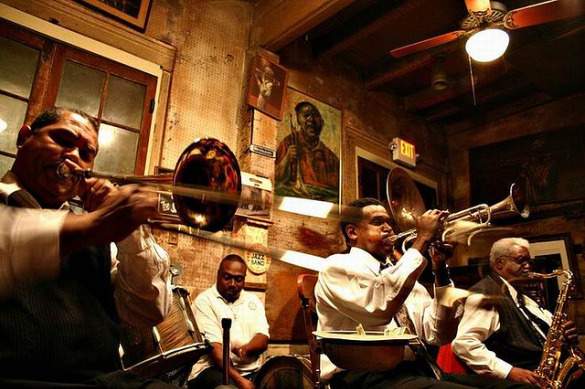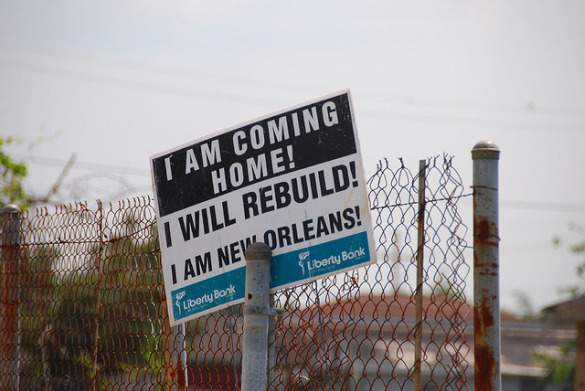On the wall of Croissant D’Or, a bakery and café on Ursulines in New Orleans, a sign says: “We’re not here for a long time, we’re here for a good time.”
We’re all endangered beings in an endangered habitat. If the sun suddenly disappeared, went out like an old bulb, the last rays of light would darken within eight minutes. Would we enjoy those last rays or fear the impending darkness?
I would fear. I would worry. But New Orleanians? They’d step into the light, pull the warmth into their bodies, and watch Earth’s last sunset. And then, they’d hold a jazz funeral for the Sun. The Washboard Chaz Blues Trio would play “Mama Died” at the Spotted Cat, Preservation Hall would open early, and Pat O’Brien’s would fill up with people drinking Hurricanes beside a fountain of water and fire. If it were spring, there would be crawfish boils. Everyone would celebrate because even though the end is near, it’s not here yet.

In Louisiana, there are continual forces that serve as constant threats to our comfortable lives. The Mississippi will flood and beg to change course no matter how many levees the Army Corps of Engineers builds. And yet, there is love and joy in Louisiana. The dark does not shut out the light. The people of New Orleans survive.
Check out these tips for having an indie travel experience in New Orleans.
In Jackson Square, a brass band plays traditional jazz tunes and Lady Gaga’s “Bad Romance.” Artists sell portraits of people and landscapes. Fortune-tellers perform palm readings as if nothing bad has ever happened, and never will again.
Near the river, four street performers address issues of race with crude jokes and break-dancing. They’re smart athletes willing to make the audience at first uncomfortable, but then getting them to laugh along when an African-American dancer asks them for donations at the end with the words, “Donate to keep us out of two places: the po’ house, and yo’ house.” He plays off the all-too-common stereotype, but it’s effective. Donations abound – especially in my section where a woman announces that she knows them, that they’re all “Ninth Ward boys” and they make their living performing this show.

In Gentilly, St. Bernard Parish, and the Lower Ninth Ward, homes squat gutted, abandoned, and lost next to proud, rebuilt houses and Brad Pitt’s “Make It Right” homes with solar panels on the roof. Everyone seems to be moving forward now – rebuilding, or tearing down, or both. And all the while celebrating being alive – even though the Army Corps of Engineers doesn’t anticipate completing Katrina-related levee repairs until next year.
The levees protect homes from many floods, but not all of them, and quell the river’s desires just enough to reverse her goal of building land, but also to make her angry, ready to fight for a flood. Every year 25 square miles of Louisiana coast and marsh disappear.
New Orleanians will not survive everything and they know it. So they make desserts extra sweet and crawfish extra spicy. Cayenne and garlic sting on the tongue and under our fingernails as we crack and eat fresh crawfish. Eating a sweet wedding cake snoball is like being punched in the throat with a sugared fist. But there’s no guilt because we’re all endangered: people, the Louisiana coast, the Gulf of Mexico sea life.

Consider the raw oyster: simple and complex. The oyster is taken from the sea, shucked, and served on the half shell. In New Orleans, I fall in love with the raw oyster. They don’t glisten with slime. They shimmer as the light dances on their plump, wet bodies. I mix the popular New Orleans condiment for oysters: ketchup, horseradish, Tabasco, and lemon juice, in a little plastic cup at the center of my plate. I spear an oyster, dip it in the sauce, place it on a saltine cracker and eat the whole messy bite. Hot. Sweet. Salty. Sexy.
I take the next one without sauce, slurp it with its juice and taste the ocean. Cold. Wet. Briny. Slippery.
I eat each one as if it’s my last. And it could be. Not only because I’m mortal, but also because oysters are threatened.
As I sit here, oil is creeping into the oyster beds, which are closed to oyster fishermen. The oil is killing the oysters, shrimp, catfish, and the livelihoods of local fishermen, some of whom have done stints working for the oil company when the shrimp weren’t giving. The river and the Gulf provide for everyone, but threaten everyone, and everyone threatens the water back.
With my feet dangling in the murky waters of the Mississippi, I watch freighters and tourist boats moving in and out of port, feel their wake a few minutes after they pass. The water is cool on my hot, tired feet. I sink into reflection as my feet swing in the water.
How many years will it take the oyster beds and other Gulf Coast sea life to recover? Will they ever recover? Are we more endangered than we thought? Is it time for a jazz funeral?

If our most important light bulb does go out or the seas begin to overtake us, I want to enjoy it to the last – learn to embody the enduring spirit of New Orleans. I want to be able to acknowledge past tragedies and the potential for future ones, but ultimately brush all possibilities aside with the words: until then we’re still here and the gumbo is almost ready, so grab an Abita or a Dixie, and crack open an extra one for me, too.
Photos by: rickz, ebatty, Eugenia Volkova, dsb nola